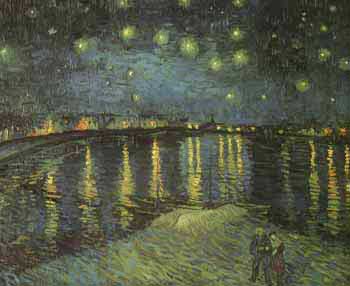
Vincent van Gogh: Starry Night on the Rhone (1888)
Homepage > A New View Of Mizar
Новы погляд на Мицар (Belorussian version)
Last year [this article has been written in 1999] saw two interesting events in the world of double stars, both of them connected with an astronomer's old friend in the Big Dipper. While the early history of double star astronomy had to be completely rewritten after an examination of 17th century Italian manuscripts, its future at the beginning of the next millennium was briefly unveiled by the amazing precision of a new astrometric instrument, which will soon eliminate the difference between spectroscopic and visual binaries.

Vincent van Gogh: Starry Night on the Rhone (1888)
As a bright naked-eye star in the conspicuous asterism, Mizar (Zeta UMa) was known since antiquity, of course, but who first resolved it with a telescope? Double star literature holds it was Giovanni Battista Riccioli (1598 – 1671), the Jesuit astronomer and geographer of Bologna, who is generally supposed to have split Mizar – as the first double star ever discovered – around 1650. [1]
For a long time I have been looking for a more specific reference to verify this claim. I asked historians of astronomy, even managed to check out Riccioli's two monumental surveys of the contemporary astronomy, Almagestum novum (1651 – quite close to the traditional date) and Astronomia reformata (1665), but failed to find a note about any double star at reasonable places. When I began to wonder if all that was just one of the numerous myths which, blindly copied from one book to another, change slowly but inevitably from information to noise, I quite unexpectedly chanced upon the elusive reference: Almagestum Novum, volume 1, part 1, page 422.
Obviously, I hadn't pushed myself hard enough while consulting the treatise, but I have an excuse. Everything what Riccioli wrote on Mizar being a double star is only the following brief note buried in the chapter On apparent and real dimensions of stars (translated by Thomas Winter): "There appears to be one star in the middle of the Great Bear's tail, when there are actually two, as the telescope reveals". [2]

Benedetto Castelli (1578 – 1643), a student of Galileo Galilei at Padua and later his devoted friend who succeeded him in the chair of mathematics at the University of Pisa, was most likely the person who first resolved Mizar (Zeta UMa) with a telescope. A modern copy of Castelli portrait whose original is in the Galleria deggli Ufizzi. Courtesy Istituto e Museo di Storia di Science in Florence and Franca Principe.
Had this been the end of the tale, this article probably would have never been written. But as Peer's Law says: "The solution to a problem changes the nature of the problem". Asking for help in
My Italian was no better than my knowledge of Galileo's life and work, but luckily I was given invaluable assistance by historians of astronomy – Albert Van Helden (Rice University), Thomas Settle (Polytechnic University, Brooklyn), Giancarlo Truffa (an independent scholar of Milan) and Thomas Winter (University of Nebraska). Truffa even revealed, in the twenty-volume National Edition [3] of Galileo's complete works edited by Antonio Favaro (1890 – 1909), two additional observations of double stars by Castelli not mentioned in Fedele's article.
The earliest evidence that the Tuscan friends were interested in Mizar is the letter Castelli sent to Galileo on November 16, 1616. [4] Described is his observation of 'a star visible only in a telescope' close to Mizar, but a glance at the sketch he included shows it was an 8th-magnitude star more recently given a curious name Sidus Ludoviciana (see box). Castelli insisted the star moved slightly from the position recorded last summer at Bellosguardo (Galileo's residence in Florence).
But the discovery of the genuine double star was already just round the corner. On January 7, 1617, Castelli wrote to Florence [5] that he kept searching for fixed stars, and asked Galileo, if his health would permit, to have a look at Mizar. "It's one of the beautiful things in the sky and I don't believe that in our pursuit one could desire better", remarked Castelli (in translation by Ken Seidenman).
It seems that Galileo complied with his friend's request on the first occasion. The National Library in Florence keeps a sheet of paper [6] with notes in Galileo's handwriting that begins with a detailed record of his observation of Mizar split into an unequal pair of stars 15 arcseconds apart, and a short calculation of its distance. For this, Galileo wrongly assumed that the angular radius of the brighter of Mizar's components he measured, 3 arcseconds, was real, compared it with the angular radius of the Sun and got the distance of only 300 astronomical units. The record isn't dated, but the ecliptical longitude of Earth given (in Cancer 25, i.e. 115 degrees) corresponds to January 15. Fedele argued quite reasonably that the year was 1617, when Galileo has just learned about Mizar from Castelli. Moreover, Galileo's interest in fixed stars in that time is well documented by another fascinating manuscript.
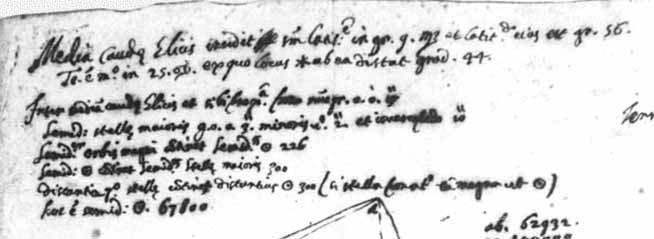
"The middle star of the Tail of Elix [Great Bear] falls, by [ecliptical] longitude, on the 9th degree of Virgo, and its latitude is 56. Earth is now in Cancer 25, out of which position the star is 44 degrees distant. Between the middle star of the Tail of Elix and the star closest to it [Mizar B], I now put 0.0.15''. The semidiameter [radius] of the large star, 0.0.3''; of the smaller, 2''; the interval, 10''. The semidiameter of the great orb [Earth's orbit] contains 226 solar semidiameters. The solar semidiameter contains 300 semidiameters of the large star. So the distance of the star contains 300 solar distances, if the star is posited to be as big as the Sun, that is, 67800 solar semidiameters."
The amazingly detailed record of the observation of Mizar in Galileo's handwriting and its translation by Thomas Winter (University of Nebraska). No date is given, but there are good reasons to believe it was made on January 15, 1617. Ms. Gal. 70 c. 10r, Biblioteca Nazionale Centrale Firenze. Reproduced with authorization from the Ministry of Cultural Activities. Any further reproduction or publication of this image is forbidden.
This observation [7], dated February 4, 1617, in Bellosguardo, is a thorough description of stars in the Orion nebula (without a word about the nebula itself). Galileo's drawing clearly shows the three brightest components of the Trapezium four decades before Christiaan Huygens. Interesting also is his remark that the pair of stars Theta_1 Ori C and Theta_2 Ori B as seen through the telescope he commonly used coincided with two stars of Orion's Belt (the middle and a side one) observed with the naked eye. This directly translates to the magnification of 27x.
Meanwhile, Benedetto Castelli discovered on January 30, 1617, a double star in Monoceros described vaguely as the easternmost star of a triangle about midway between Canis Major and Betelgeuse. [8] Ten years later, in the summer 1627, by which time Castelli was called to Rome by Pope Urban VIII as a consultant on the regulation of rivers, he revealed the 5th-magnitude companion of Beta Scorpii [9] (today separated by 13.7 arcseconds from the 2.6-magnitude primary).
According to Fedele, Benedetto Castelli and Galileo Galilei became interested in double stars because they wanted to prove Earth's motion around the Sun. The principle of the Galileo method, explained later in his Dialogue on the Two Chief World Systems [10] (the book used by the Inquisition as the pretext for the infamous trial), was simple. If one finds with a telescope a close pair of stars, one bright and thus presumably closer to Earth, and the other fainter and farther (that is, an optical double star), the revolution of Earth should manifest itself in changes of their relative position. Castelli didn't write in the letters to Galileo (no reply from Florence survived, unfortunately) about their aims openly, but one can imagine that he preferred to discuss that in person. The declaration made by the Pope that the Copernican doctrine is contrary to the Bible and therefore cannot be defended or held, was notified to Galileo already during his visit to Rome in early 1616.
Whatever was the motivation of the first double star observers, they didn't detect any credible relative motion. When Galileo prepared Dialogue (published in 1632), the best empirical evidence he could put forward of Earth's motion around the Sun was ironically the tides of sea which have nothing to do with it. Today it's clear that the attempt to use observations of Mizar to support the Copernican view of the universe was condemned to failure from the very beginning.
The reason is simple – the components of Mizar (STF 1744, ADS 8891), despite the two-magnitude difference, are at the same distance from us, bound together by gravity and orbiting around each other. Existence of such binary stars was proved by William Herschel in 1803 [11] (it's worth a note that Herschel originally just wanted to apply the Galileo method). The orbital motion of Mizar is quite slow. Compare the first reliable measurement of Mizar made by James Bradley and reduced to the epoch 1755 – position angle 143.1 degrees and angular distance 13.88 arcseconds, with the result of the Hipparcos satellite: 152 degrees and 14.43 arcseconds (epoch 1991.25). The observed arc is too short to tell us anything useful about the orbit, but the separation suggests a period of few thousand years.
Of the hundreds of measurements made between Bradley and the Hipparcos, one made history by having introduced photography to astrometry. That happened in the charming pioneering times at Harvard College Observatory just after 1850, when a photographic camera was called "actinic apparatus" and Polaris was beyond the reach of a daguerrotype. With the coming of wet collodion plates and a new clock drive for the 15-inch refractor, the photographer John A. Whipple and the observatory director George P. Bond succeeded in taking the first photograph of a double star, Mizar, on the evening of April 27, 1857. Measured on the following day by Alvan Clark with a reading microscope, it gave results consistent with visual measurements by Wilhelm Struve. [12] By the end of the summer, Bond measured over 80 photographs of the double star and demonstrated that the photographic method was more precise than a micrometer in the hands of the best double star observers. [13]
And still one astrometric issue, the mysterious dark object invented to explain alleged oscillations of the relative position of Mizar A and B. In short, the oscillations have never been proved and there is no need for such an invisible component. But once you open a can of worms, it's quite hard to recan them, and the ghost star is likely to live in popular literature forever.
I mean a specific shade at the extreme limit of human eye's sensitivity which, being taken away from the light of stars and galaxies by singly ionized calcium, played a prominent role in the history of astrophysics. One of the Fraunhofer lines with the laboratory wavelength of 393.4 nanometers, it was designated K by J. W. Draper, professor of chemistry in New York. [18] The curriculum vitae of the K line includes such exciting discoveries as the expansion of the universe (1929) [19], the existence of interstellar matter (1904) [20] and also the first spectroscopic binary star, Mizar A (1889).
In the late 1880s, astronomers at Harvard College Observatory were busy with the Henry Draper Memorial, a program funded by Anna Palmer Draper who wished to establish a monument to her late husband, an American pioneer in astronomical spectroscopy and son of J. W. Draper. Remarkably, one part of the project was assigned to Henry Draper's niece, Antonia C. Maury, who was employed at Harvard as a research associate. Her task was to devise a suitable system of spectral types and classify objective-prism spectra of bright northern stars taken with the 11-inch Clark refractor.


Two of the spectra of Mizar A which made history, taken at Harvard College Observatory in the spring 1887. While the K line of calcium is double on the detail of the first plate (of March 27), it became single by April 5, when the second spectrogram was taken. The other line is H_epsilon of hydrogen. Courtesy Harvard College Observatory and Martha Hazen.
In the course of the work, she noticed various oddities, among them a curious doubling of the K line on one spectrogram of Mizar A. [21] The follow-up examination of all plates led to belief that the line was double (with the separation of 0.2 nanometers) at intervals of 52 days and that several days before and after those dates it presented a hazy appearance. The only satisfactory explanation found was that Mizar A is itself a binary star with the components nearly equal in brightness and too close to split visually. Providing further that the orbital period was 104 days and the orbit circular, the Doppler effect would double the spectral lines as observed. The discovery was announced by Edward C. Pickering, the observatory director, on November 13, 1889, at the Philadelphia meeting of the National Academy of Sciences, and the model was seemingly confirmed when the predicted line doubling occured on December 8th. [22]
Here ends a textbook version of the historic event. In reality, the Harvard astronomers had increasing troubles with the archetype of spectroscopic binaries. They first reduced the orbital period to one half, then allowed the orbit to be elliptical, even blamed a third body for irregularities in period, but the K lines of Mizar A still refused to stick to the schedule. [23]
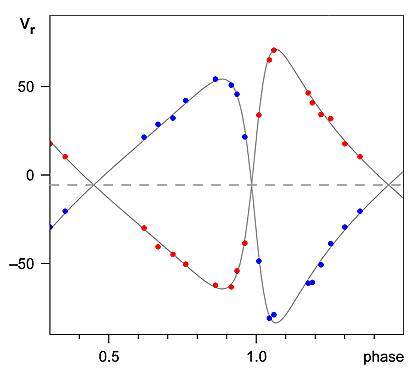
Radial velocity curve of Mizar A (above) [25] and Mizar B (bellow) [26]. The most important difference is that Mizar A, unlike its handicapped neighbor, is a double-lined spectroscopic binary. That's a necessary condition for weighing its components and calibrating models of main-sequence stars. Orbits of both binaries are conspicuously elliptical with eccentricities around 0.5.
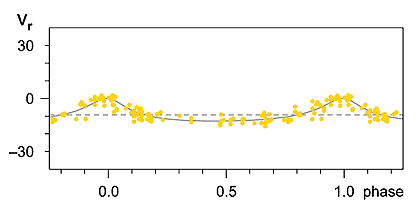
The case was closed only twelve years after the discovery on the other side of the Atlantic, thanks to Hermann Carl Vogel and his colleagues at Potsdam Observatory. [24] A series of excellent plates secured with the spectrograph at the 30 cm refractor in the spring season of 1901 enabled them to follow the separation of the lines nearly continuously for five weeks. Plotted on graph paper, the data at once revealed that the orbital period was only twenty and a half days, and the orbit was highly elliptical with its major axis roughly perpendicular to the line of sight. Now it was easy to understand what conspired against Pickering and Maury. The spectral lines doubled themselves twice a revolution as they expected, but at phases only four days apart, and the lines became perfectly single in the meantime!
Amazingly, in 1908 Edwin B. Frost at the Yerkes Observatory [27] and Hans Ludendorff in Potsdam [28] independently announced radial velocity variations also in the spectrum of Mizar B, the fainter star of the visual pair. Only one set of absorption lines is visible because the other component is too faint to assert itself in the common spectrum. Moreover, the orbital motion of this binary is much slower than in Mizar A and its understanding was also correspondingly slower. Even in 1961, half a century after the discovery, Helmut Abt concluded that the period is about one year, twice the correct value of 175.6 days.
Before the 1920s, the quadruple system of Mizar illustrated two distinct types of binaries discovered and examined by two independent methods. On the one hand visual binaries, wide enough to pinpoint the components in the sky but too slow in orbital motion to show radial velocity changes. On the other hand spectroscopic binaries, with conspicuous motion in the third dimension, but too close to resolve with conventional telescopes. The problem is that you must combine both approaches to find the masses of orbiting stars, the fundamental property which determine their evolution.
A little consideration shows that the angular separation of Mizar A cannot much exceed pessimistic 0.01 arcseconds, about a third of the Hubble Space Telescope's resolution. Yet the binary was resolved already in 1925, when the art of interferometry, mastered in physical labs by Albert A. Michelson at the end of the 19th century, began to bridge the gap between visual and spectroscopic binaries.
Although Mizar A was not the first spectroscopic binary to be measured by this innovative technique – this priority belongs to bright Capella – it was observed by the first (and for many years also the last) functional astronomical interferometer, the 20-foot constructed by Michelson and Francis G. Pease at Mount Wilson. The seven measurements made in 1925 and 1927 had an error of several degrees in the position angle while the angular distance was overestimated by about twenty percent, but at least the 60 degrees inclination of the apparent orbit computed by Henry N. Russell was correct. [29]

An aerial view of the Navy Prototype Optical Interferometer (NPOI) on Anderson Mesa, 14 miles southeast of Flagstaff, Arizona, as it appeared in October 1996. The cluster of white buildings at the center houses the four siderostats of the astrometric array. The six imaging siderostats can be mounted on any one of the concrete piers apparent along the arms of the Y, providing the maximum baseline of 437 meters. The NPOI is a joint project of the Naval Research Laboratory (NRL) and the US Naval Observatory (USNO) in cooperation with the Lowell Observatory. Courtesy Christian Hummel (USNO).
The 20-ft interferometer represented the limit of technological capabilities until about twenty years ago, when the field has been revolutionized by computer controlled active optics, fast and sensitive light detectors, and other technical advances. A fascinating example of a state-of-the-art descendant of Michelson's instrument is the Navy Prototype Optical Interferometer (NPOI) that nears completion on Anderson Mesa in Arizona. From an overhead view it much resembles a pocket edition of the Very Large Array, a well-known radio observatory in New Mexico. That similarity is not coincidental, since the NPOI will use the same method, called aperture synthesis, to create images of spotted cool supergiants, gaseous disks around Be stars, or tiny spectroscopic binaries.
The NPOI collects light waves from a source by ten siderostats (flat mirrors on altitude-azimuthal mountings, which send the light to an evacuated optical system for further processing) arranged in two specialized arrays. The astrometric array has four siderostats with 35 cm apertures mounted on fixed stations with the maximum baseline of 38 meters. Designed to determine absolute positions in the sky with milliarcsecond precision, it's expected to improve on the Hipparcos satellite results for stars brighter than about 8th magnitude. For pairs of stars close enough to measure simultaneously, the astrometric accuracy should be better than 0.01 milliarcseconds. That will allow for discovery of giant planets in nearby binary stars – the amplitude of the Sun's reflex motion due to Jupiter seen from 10 parsecs distance is one millisecond.
The other six siderostats of the NPOI, with 12 cm apertures, form the imaging array. They can be mounted on any one of concrete piers built along three 250-meters-long arms. When the imaging array is fully operational, it will synthesize images with a resolution of an amazing 0.2 milliarcseconds (the size of an astronaut's footprint on the Moon). With something like that you can measure diameters of the majority of naked-eye stars or resolve all binary stars within one thousand light years with periods longer than one day.
The first stellar object that in May 1996 sat for its NPOI portrait was our old friend, the 20.5-day spectroscopic binary Mizar A. [30] Only three of the astrometric siderostats were exploited so the resolution was not adequate for actually showing disks of the components (expected to be some 0.8 milliarcseconds in diameter), but their relative position could be measured with the precision of about 0.1 milliarcseconds. That's better than one percent of the typical separation – the apparent orbits of few binary stars are that smooth.
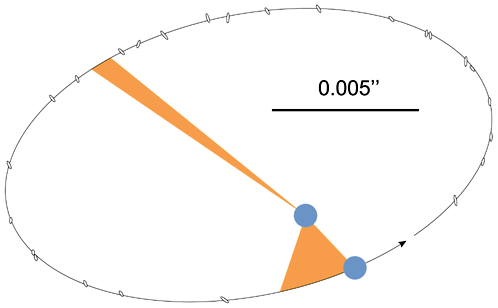
The breathtaking orbit of the 20.5-day binary Mizar A based on observations with three siderostats of the NPOI's astrometric array (maximum baseline of 38 meters). A further improvement of a few times can be expected when the imaging array is fully operational. Even so, the precision of the relative position is unprecedented – the size of small ovals along the orbit indicate the measurements errors, typically some 100 millionths of arcsecond! The blue disks show the angular diameters of stars calculated from their parallaxes, colors and magnitudes. The two orange segments shows the areas swept out during the same interval of half a day near periastron and apastron. North is up. Courtesy Christian Hummel (USNO).
What's the astrophysical picture of the first spectroscopic binary after the NPOI? Mizar A's stars orbit each other with period of 20 days 12 hours 55 minutes and 13 seconds at a distance which changes from 16 to 54 million kilometers. Transferred to the solar system, the binary would be just inside Mercury's orbit. As regards physical properties of the components, they are virtually identical in brightness, spectral type (A2V), effective temperature (9000 K) and radius (2.4 greater than Sun's). The only, but most important, difference relies on the latest spectroscopic orbit, published by Ch. Fehrenbach and L. Prevot in 1961. Combined with the NPOI positions, their measurements suggest the stellar masses to be 2.43 and 2.50 solar ones, but the radial velocities should be taken with caution and the mass ratio may be reversed in future. The binary itself will answer the question when it's some 600 million years old. Then the more massive component will exhaust its hydrogen fuel somewhat earlier than the other, expand in attempt to become red giant, and make Mizar A an interacting binary. Hopefully, we won't have to wait that long to complete the portrait of one of the most beautiful things in the sky.
It's impossible to write a comprehensive article on Mizar and leave out its two famous neighbors. The first one, Alcor (80 g UMa), easy to spot with the naked eye at distance of 11 arcminutes, was sometimes considered a fifth member of the Mizar system. This notion was made less likely by the Hipparcos distances to Mizar (78 light years) and Alcor (81 light years) which have the uncertainty of only one light year each. Nonetheless, the stars share the motion in space and were formed together as close members of the nearest star cluster, Collinder 285, better known as the Ursa Major moving cluster. It was recognized in 1869 by the English astronomer Richard A. Proctor who noticed that five stars of the Big Dipper (Beta, Gamma, Delta, Epsilon and Zeta UMa) hurried together towards the solar apex in Hercules rather than away from it like most other stars in the sky. [14] The current view of Collinder 285 is that of a sparse doomed cluster, 300 or 400 million years old, with some 50 members scattered all over the sky. The five Proctor stars and a few fainter ones (like Alcor) form its nucleus.
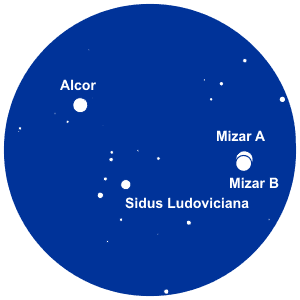
Four richly storied stars in this 15' field were within reach of the simple telescopes of Galileo Galilei and his friend Benedetto Castelli. These are Mizar A (Zeta_1 UMa, 2.27 mag), the famous 20.5-day spectroscopic binary discovered in 1889 and imaged with the NPOI in Arizona a century later, Mizar B (Zeta_2 UMa, 3.95 mag), its visual companion 15 arcseconds away, also a spectroscopic pair of stars which orbit each other twice a year, Alcor (80 g UMa), a single but variable star (one of the Hipparcos discoveries, 4.04 – 4.07 mag), and finally Sidus Ludoviciana (HD 116798, 7.59 mag), a star once considered a new planet.
Another popular misconception, repeated even in the Hipparcos Catalog, is that Alcor is a spectroscopic binary star. The fable goes back to the very same paper in which Frost announced the radial velocity variations of Mizar B, but most modern sources seem to rely on a 50 years old study by John F. Heard. Anyone who manages to locate that 1949 issue of Astrophysical Journal [15] can see that the radial velocity fluctuated chaotically from about -35 to +10 kilometers per second during minutes or a few hours, something a well-behaved binary star is certainly not expected to do. Absorption lines in the spectrum of Alcor are smeared by fast rotation (the equatorial velocity is at least 200 kilometers per second) and thus hard to measure. But if the Heard velocities are real they could well reflect the light variability discovered by the Hipparcos which is similarly erratic. Alcor's brightness changes between magnitudes 4.04 and 4.07 (in the Hipparcos system) with no apparent period.
Observed already by Benedetto Castelli in 1616, an 8th-magnitude star in the Mizar field became known as Sidus Ludoviciana a century later. [16] Johann Georg Liebknecht (1679 – 1749), professor of theology and mathematics at the German university of Giesen, noticed this star on December 2, 1722, while observing with a nonachromatic telescope six feet long. Believing he detected its slow motion among stars, Liebknecht became convinced it was a new planet and named it hastily Sidus Ludoviciana (Ludwig's star) in honor of his monarch, the Landgrave Ludwig of Hessen-Darmstadt. Liebknecht was however much less lucky than Galileo with his Medicean stars (Jupiter's four satellites) or William Herschel who named the genuine seventh planet, Uranus, after his sovereign King George III. While both of them enjoyed the favor of the mighty patrons as well as recognition by fellow astronomers, Liebknecht's pamphlet [17] announcing the find was sharply criticized, to put it mildly, by his colleagues who dismissed it as nonsense.
Apart from this curious tale that can enliven any public observation of Mizar through a telescope, Sidus Ludoviciana is a run-of-the-mill field star which has nothing to do with the Ursa Major cluster. A comparison of its visual magnitude with that of Alcor (which has the same spectral type A5 V) shows it's roughly five times farther.
(Click on a footnote number to return to the main text.)
[1] For example Robert Grant Aitken, one of the best observers of double stars, opened the first chapter of his classic book The Binary Stars (New York, 1918, p.1) with these words: "The first double star was discovered about the year 1650 by the Italian astronomer, Jean Baptiste Riccioli. This was Zeta Ursae Majoris (Mizar)". Note the French form of the Riccioli name.
[2] A facsimile of the original text (in Latin) and its complete translation by Thomas Winter is available here.
[3] Le Opere di Galileo Galilei. Edizione Nazionale Sotto Gli Auspicii Di Sua Maestà Il Re D'Italia, Edited by Antonio Favaro, 20 vols., G. Barbèra, Florence, 1890–1909
[4] Opere, Vol. XII (1902), p. 296 (Letter 1236). Mss. Gal. P.VI, T.X, car. 16, BNCF.
[5] Opere, Vol. XII (1902), p. 301 (Letter 1241). Mss. Gal. P.III, T.VII, 2, car. 62, BNCF.
[6] Opere, Vol. III, Part II (1892), p. 877. Mss. Gal. P.IV, T.VI, car 10r, BNCF.
[7] Opere, Vol. III, Part II (1892), p. 880. Mss. Gal. P.III, T.IV, car 208t, BNCF.
[8] Opere, Vol. XII (1902), p. 309 (Letter 1248). Mss. Gal. P.VI, T.X, car 21, BNCF.
[9] Opere, Vol. XIII (1903), p. 372 (Letter 1834). Mss. Gal. P.VI, T.XI, car 69, BNCF.
[10] "For I do not think the stars are lying on a spherical surface equidistant from the center, but rather I judge that their distances from us vary to such an extent that some may be two or three times farther than others; hence, if the telescope should reveal some very small and very distant star very close to one of the largest, it could happen that they would exhibit some perceivable variation corresponding to that of the superior planets." (translation by Maurice A. Finocchiaro, in Galileo On The World Systems, University of California Press, Berkeley, 1997, p. 271).
[11] Herschel, W. 1803, Philosophical Transactions 93, 339–382
[12] Bond, G. P. 1857, Monthly Notices RAS 17, 230–232
[13] Bond, G. P. 1858, Astronomische Nachrichten 47, 1–6; Bond, G. P. 1858, Astronomische Nachrichten 48, 1–14
[14] Proctor, R. A. 1870, Proc. Roy. Soc. of London 18, 169–171
[15] Heard, J. F. 1949, Astrophys. J. 109, 185
[16] Olbers, W. 1803, Monatliche Korespondenz 8, 528–531 (reprinted in Wilhelm Olbers Sein Leben Und Seine Werke, ed. C. Schilling, Bd.I – Gesammelte Werke, Julius Springer, Berlin, 1894, p. 523-525); Ashbrook, J. 1957, Sky & Telescope, April, p. 265, 270, and June p. 378
[17] Despite all my efforts, I failed to locate a copy of the pamphlet in European libraries. According to Olbers, its full title is quite long:
D. Jo. Georgii Liebknecht, Mathem. in Universitate Ludoviciana P. P. nec non Societ. Caesar. et Regiae Boruss. Colegae uberior stellae Ludovicianae noviter detectae et cum nuper serenissimus Princeps ac Dominus, Dr. Ludov. Joh. Guil. Gruno, Landgravius Hassiae, Princeps Hersfeld., Comes in Cattimelioboco etc. Dominus meus clementissimus, Ludovicianae Rector magnificentissimus, sceptra clementissime susciperet, publicatae consideratio, nonnullorum dubiis et iniquis praesertim scommatibus Ludov. Phil. Thümmigii inter Hallenses A. O. P. novi rerum naturalium tentatoris opposita. Gissae, litteris Joh. Mülleri 1723. 4. 16 S.
[18] Draper, J.W. 1843, Phil. Mag. (3) 22, 360
[19] Hubble, E. 1929, Proc. Nat. Acad. Sci. 15, No. 3
[20] Hartmann, J. 1904, Astrophys. J. 19, 268
[21] It seems that the first published remark appeared in Henry Draper Memorial. Third Annual Report (Edward C. Pickering), University Press, Cambridge, 1889, p. 5: "Various peculiarities in the spectra of individual stars have been detected. One photograph of Zeta Ursae Majoris shows the K line distinctly double, and others show it single. Many photographs will be required to determine the law of its variation, if this is due to changes in the star itself."
[22] Pickering, E. C. 1890, Amer. J. of Science (3rd Ser.) 39, 46
[23] Pickering, E. C. 1890, Sidereal Messenger 9, 80–82; Pickering, E. C. 1890, Monthly Notices RAS 50, 296–298; Pickering, E. C. 1896, Harvard College Observatory Circular #11
[24] Vogel, H. C. 1901, Astrophys. J. 13, 324–328
[25] Fehrenbach, Ch., Prevot, L. 1961, Journal des Observateurs 44, 83–87
[26] Gutmann, F. 1968, Publications of the Dominion Astrophysical Observatory 12, 361–371
[27] Frost, E. B. 1908, Astronomische Nachrichten 177, 171–174
[28] Ludendorff, H. 1908, Astronomische Nachrichten 177, 7–10
[29] Pease, F. G. 1927, Publ. Astron. Soc. Pacific 39, 313–314
[30] Hummel, C. A. 1998, Astron. J. 116, 2536–2548